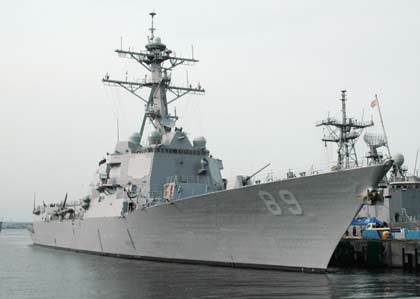Asia-Pacific
US destroyer arrives in Japan
(Reuters)
Updated: 2006-07-09 10:34
 |
Large Medium Small |
A US Navy guided missile destroyer with the navy's most advanced combat weapon system arrived in Japan on Saturday as tensions surrounding North Korea's missile tests remained high.
 The 9,200-ton USS Mustin, a US Navy guided missile destroyer equipped with the navy's most advanced Aegis combat weapon system, arrives at the Yokosuka base, near Tokyo July 8, 2006. The USS Mustin, with a crew of 300 sailors and equipped with missile tracking and engaging capability, will be permanently deployed at Yokosuka, a US Navy spokeswoman said. [Reuters] |
The USS Mustin, equipped with missile tracking and engaging systems and with a crew of 300, will be permanently deployed at the navy's Yokosuka base in Tokyo Bay, US Navy spokeswoman Hanako Tomizuka said.
The US Navy now has eight vessels equipped with its Aegis weapon system at Yokosuka, home of its Seventh Fleet. They are scheduled to be joined next month by the Aegis cruiser Shiloh, which last month took part in an exercise off Hawaii that involved successfully intercepting a missile in flight.
Separately, Japan's Maritime Self-Defence Force conducted a missile firing drill off the Hawaiian island of Kauai on Friday as part of a multinational exercise, Kyodo news agency said on Saturday. Three destroyers each successfully fired a missile at an unmanned target aircraft, it said.
North Korea conducted missile tests on Wednesday, including the launch of a long-range Taepodong-2 missile.
The country said that it has the right to test the missiles, and has said it would consider sanctions against it as a declaration of war.
Japan also banned a North Korean ferry, the only regular direct link between the two countries, from entering its ports for six months as part of a package of initial sanctions.
According to a poll conducted on Friday and Saturday by Kyodo, 87 percent expressed anxiety on North Korea's missile firings, with 45.2 percent saying they "feel very anxious" and 41.8 percent saying they "feel somewhat anxious".